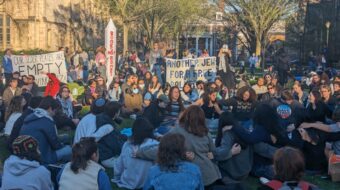
“Some of the men said they’re prepared to die this time, because they feel that they’re being killed slowly anyway.”
The above quote comes from a supporter of Prisoner Hunger Strike Solidarity, a coalition set up in alliance with the striking prisoners in California’s prison system. The prisoners re-started a temporarily suspended hunger strike Sept. 26, now in its second week.
“This is the largest prisoner strike of any kind in recent US history,” says Ron Ahnen of California Prison Focus in a press release, “The fact that so many prisoners are participating highlights the extreme conditions in all of California’s prisons as well as the historic opportunity the state has been given to make substantial changes.”
Indeed, reports indicate that the prisoners are becoming more militant. In the July wave of the strike, an estimated 6,600 prisoners participated. Now, during the first week of the renewed strike, more than 12,000 were reported to have participated.
The strike started in the notorious maximum security Pelican Bay State Penitentiary – specifically its SHU, or Secure Housing Unit – and spread across the system, to 13 out of 33 prisons, as well as to private, contracted out-of-state jails.
The inmates first started their hunger strike July 1 to protest “cruel, inhumane and tortuous conditions of their imprisonment [and] to improve the treatment of SHU-status prisoners throughout California.”
“For the past 10-40 years,” said a press release from the solidarity coalition, “thousands of California prisoners have been confined in [Secure Housing Units] indefinitely based on status [E.G., a gang label – active gang classification, based on innocuous association activity, and allegations from confidential inmate informants] – wherein, they have been demonized as the worst-of-the-worst, in order to justify decades of human rights violations – including state sanctioned torture for the purpose of breaking the prisoners, and coercing them into becoming known informants for the state – thereby placing such prisoners, and their families in serious danger of retribution.”
The strike’s five “core demands” include the ending of group punishments for rules violations by a single prisoner; abortion of policy in which inmates were forced to “snitch” on each other and the detention of prisoners in the SHU for perceived gang activity; an end to long-term solitary confinement; “adequate and nutritious food” and “constructive programming and privileges,” such as weekly phone calls, one photo per year, education and so on.
The prisoners weren’t the only ones critical of the California jails. One of their key demands is the ending of long-term solitary confinement, still employed in state prisons. But in 2006, the U.S. Commission on Safety and Abuse in Prisons officially called for ending that punishment.
The strike’s first wave, which lasted through July 20, at first seemed to have some effect. The prisoners entered into negotiations with the California Department of Corrections and Rehabilitation. On July 20, CDCR Undersecretary Darby Kernan assured the prisoners that the state would meet their five demands. The strike was suspended to give the state time to implement the changes.
Instead, say prisoner representatives, Kernan only gave vague assurances of change in several follow-up meetings and even went so far as to lie to the Public Safety Committee of the California State Assembly about the conditions in Pelican Bay and the system overall. Consequently, strike leaders called for the resumption of the hunger strike Sept. 26.
“As of September 2011,” the solidarity coalition said in explaining the resumption of the strikes, “these SHU-prisoners continue to be subjected to CDCR’s torturous human rights violations in spite of the July 2011 peaceful protest via hunger strike, wherein thousands of prisoners of all races/groups united in their effort to bring mainstream exposure and force an end to such barbarous policies and practices. CDCR has responded with more propaganda, lies, and vague double talk promises of change in time.”
The Department of Corrections and Rehabilitation appears to now be currently more inclined toward fighting than negotiations. “A number of family members received notice that they were not going to be allowed to see their loved ones as long as the strike continues,” Dolores Canales who has a son in the Pelican Bay Secure Housing Unit, said in a press release.
“Denying visits only heightens the isolation that the prisoners and family members experience, especially at this critical time,” she continued.
Still, the prisoners seem steadfast. According to a supporter, “They’ve chose the only weapon that they can use that’s at their disposal, and that’s themselves.”
Photo: Creative Commons 2.0












Comments